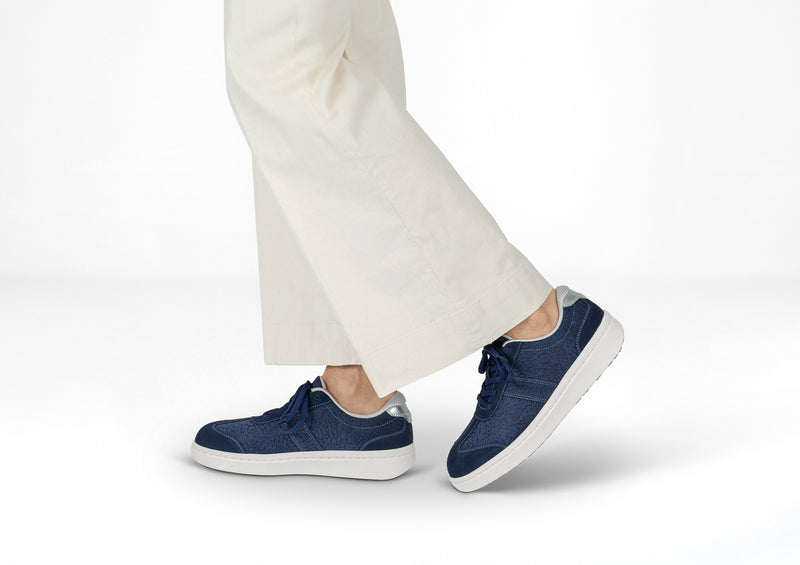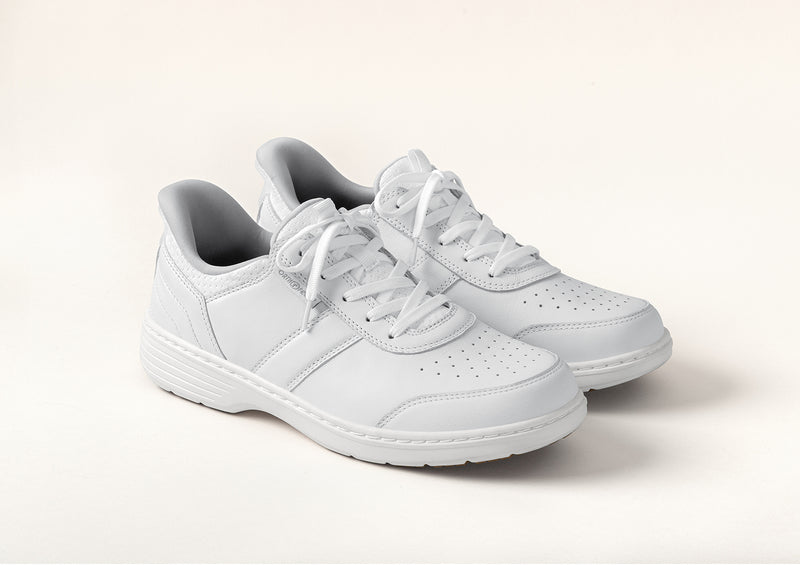Bunions are very common, but that does not mean they are a trivial issue. When bunions are severe, they can evolve into a debilitating condition and even require surgery.
If you have bunions, there are quite a few things you can do to prevent them from deteriorating.
What is a Bunion?
The medical term for a bunion is "Hallux Abducto Valgus “, or just "Hallux Valgus”.
 Bunions are a deformity of the big toe area of the foot that looks like a bump on the inside or medial side of the foot, just behind the big toe on the first metatarsal head, and the big toe angulates toward the second toe.
Bunions are a deformity of the big toe area of the foot that looks like a bump on the inside or medial side of the foot, just behind the big toe on the first metatarsal head, and the big toe angulates toward the second toe.The bump is actually the first metatarsal head that has shifted out away from the foot and widened it.
This bump can enlarge due to inflammation from shoe pressure rubbing on it.
Bunions can cause pain from inflammation, poor shoe fitting, balance issues from biomechanical changes in the foot from the altered anatomy, and other problems.
How Do Bunions Occur?
Generally, bunions are a result of biomechanical flaws in the foot that are genetic or congenital.
It is common to see bunions go from generation to generation, most commonly in women. Women are more prone to bunions, because they tend to have more flexible joints and ligaments, including in the foot, due to the necessity to give birth. This results in increased motion that allows any biomechanical flaws to be exacerbated, causing shifting of the bones and then bunions.
Shoes can also be an issue. In addition, arthritis and other joint and connective tissue disorders can add to bunion formation.
Do Bunions Get Progressively Worse?
In most cases, bunions get worse gradually only if you don’t wear the right shoes and don’t get any treatment. Adequate shoes are critical to alleviating bunion pain and discomfort, and making sure they don’t become worse.
While shoes alone don't create bunions, they can amplify the underlying biomechanical flaws. Shoe types such as dress shoes, high heels, pointed toe box and slip on shoes are all culprits.
4 Tips On How To Prevent Bunions From Getting Worse
First, I want to point out one thing: bunions cannot be prevented if they are a result of a foot structure you were born with. However, the speed of formation and severity of deformity can be affected and slowed.
All other causes of bunions can be prevented with proper support and shoes.
The underlying biomechanical issues we are born with are potent and cannot be changed easily. Once we put shoes on at a young age, we fundamentally change the shape and biomechanics of the foot forever.
It’s like orthodontia for the teeth. Shoes immediately put pressure on the forefoot forcing the toes together and pushing the big toe inward, changing the anatomy, including the shape of the bones and the location of the cartilage.
Looking at pictures of feet in some societies that never wear shoes, you can clearly see feet that look dramatically different than the feet that wear shoes. Without shoes, the toes are separated in a way that looks like a hand.
Seeing as bunions can develop into a debilitating condition that might even require surgery, here are some tips on how to treat your bunions correctly, before they become too severe.
1. Don’t wear the wrong shoes
Shoes can and do affect the severity of the anatomical changes that occur in bunion formation, and the associated symptomology.
Basically, the more the shoe forces the big toe toward the second toe and allows excess motion, the worse the deformity. That’s why narrow pointed toe box shoes are a major factor.
Unfortunately, many women's shoes are shaped that way for style. High heels are particularly damaging as they force the foot into an altered biomechanical position and jam the forefoot and big toe into the floor, shifting the big toe’s position.
2. Orthotics are important
As noted above, excess motion in the foot is one major cause of bunions and one cause of excess motion is over pronation.
Pronation is a natural motion the foot goes through as we walk and stand that loosens the foot. Pronation rolls the foot inward and drops the arch. This allows shock absorption and adaptation to changes in the terrain, so the foot can deal with uneven surfaces.
In over pronation, the arch drops downward or inward excessively, a common issue in many foot problems. We can treat over pronation and the resulting excess motion it causes with orthotics in the shoes.
Orthofeet designs well-made over the counter orthotics that are designed to support the arch, control over pronation, align the foot and correct the gait. I use a lot of these in practice and they have helped my patients tremendously.
In more severe cases, a true rigid custom orthotic is required. Although there is no definitive proof of this, it is believed by many podiatrists that orthotics started early can significantly alter the severity of bunions and slow down the progression.
3. Know which shoes to look for
In addition to orthotics, shoes are the other significant factor in bunion formation and severity. As noted above, shoes that have a narrow or pointed toe box are a major factor in speeding up and increasing severity of bunion formation.
The best bunion shoes should be designed with the following features:
- Shoes for bunions need to have a wide, round and high toe box. The less pressure on the big toe, the better. Orthofeet shoes have a very round deep toe box with lots of room. I wear them myself, due to the comfort factor and since members of my family had severe bunions and I have the excess pronation and motion that could form bunions.
- If you already have bunions, the best shoes for bunions should have a round toe box and extra depth for the big toe, often being over or under the second toe.
Also, extra depth shoes are critical, because they add stability and reduce motion, and can easily accommodate orthotics.
- Wide or extra wide shoes also are critical for bunions.
Most shoes found today in big box stores only carry one width, usually medium, which is far from what a bunioned foot needs. The good news is that specialty footwear brands design shoes in extended widths - from narrow all the way up to extra extra wide! In many cases, bunion pain relief is as easy as wider shoes with a round toe box.
- The material of the shoes is very important for feet with bunions.
Shoes constructed with tight and unforgiving materials will apply pressure on the bunion, worsen the condition and cause pain. However, shoes made with stretch knit uppers offer a relaxed fit and conform to the contours of your foot, specifically the bunion, to create a pressure free environment.
Supple leathers can also work well. I have many patients with very wide feet from bunions who wear these after failing in most other shoes.
Whatever material they are made of, it is important the upper is free of overlays or stitching across the sensitive bunion area. The interior of the shoe should be soft and padded to offer the utmost protection, preventing any further injury or friction to the painful area. Ideally, a seam free construction is best.
- Shoes for bunions should have a low heel or be flat to the ground to avoid forcing the forefoot into the floor, as is the case with heels.
- It’s also best to look for shoes that have an ergonomic sole with a mild rocker bottom that facilitates foot motion and transfers weight evenly from the rearfoot to the forefoot.
4. Other Bunion Relief Options
Minimizing pain and providing relief is key if you have a bunion and there are other options that are available for those who have minor cases of the condition.
- Bunions Socks. Bunion socks are not a means to prevent the deformity, but they can provide added benefits, such as separating the big toe from the remaining toes. This ensures the toes do not overlap and rub against each other, causing irritation. Orthofeet also offers bunion socks and they are super comfortable, as they’re made with soft bamboo fibers, offer a non-binding fit and wick moisture away from the foot.
- Bunion Pads. If you are looking to protect the bunion from anything that touches and rubs against it, bunion pads can help. Note that some pads are medicated with acid in them that can burn the skin. Do not use these! Simple protective pads will do the job just fine.
How to Stretch Shoes for Bunions
Although not my first choice and not as effective in treating and preventing bunions, there are some who like to make shoes wider for bunions by stretching them.
The one useful device I have in the office to accommodate for the large bump of the bunion on the side of the foot is the Ball and Ring Stretcher. This device pushes out the toe box in one spot only, directly over the bump. Most podiatrists have this device and will be able to stretch your shoes if you bring them in.
But, while stretching your shoes is helpful I want to reiterate that the best solution for people with bunions is to buy special shoes for bunions, like Orthofeet’s bunion shoes, which come with all the design features I mentioned earlier: a wide toe box, soft stretchable uppers and special orthotic insoles that provide arch support, reduce over pronation and help straighten the toes.
See your podiatrist for more information and help with bunions. In the worst cases, surgery can correct bunions permanently. Surgery is the only true bunion corrector as it gets to the root of the problem.


